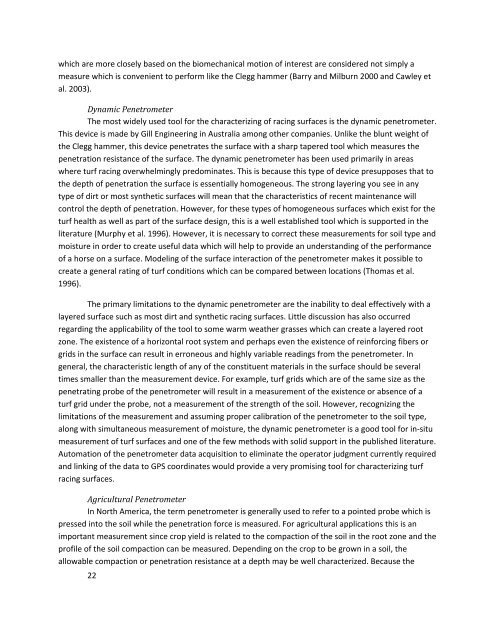Retired Racehorses
tfrr_reportandappendicesfinal
tfrr_reportandappendicesfinal
- No tags were found...
You also want an ePaper? Increase the reach of your titles
YUMPU automatically turns print PDFs into web optimized ePapers that Google loves.
which are more closely based on the biomechanical motion of interest are considered not simply a<br />
measure which is convenient to perform like the Clegg hammer (Barry and Milburn 2000 and Cawley et<br />
al. 2003).<br />
Dynamic Penetrometer<br />
The most widely used tool for the characterizing of racing surfaces is the dynamic penetrometer.<br />
This device is made by Gill Engineering in Australia among other companies. Unlike the blunt weight of<br />
the Clegg hammer, this device penetrates the surface with a sharp tapered tool which measures the<br />
penetration resistance of the surface. The dynamic penetrometer has been used primarily in areas<br />
where turf racing overwhelmingly predominates. This is because this type of device presupposes that to<br />
the depth of penetration the surface is essentially homogeneous. The strong layering you see in any<br />
type of dirt or most synthetic surfaces will mean that the characteristics of recent maintenance will<br />
control the depth of penetration. However, for these types of homogeneous surfaces which exist for the<br />
turf health as well as part of the surface design, this is a well established tool which is supported in the<br />
literature (Murphy et al. 1996). However, it is necessary to correct these measurements for soil type and<br />
moisture in order to create useful data which will help to provide an understanding of the performance<br />
of a horse on a surface. Modeling of the surface interaction of the penetrometer makes it possible to<br />
create a general rating of turf conditions which can be compared between locations (Thomas et al.<br />
1996).<br />
The primary limitations to the dynamic penetrometer are the inability to deal effectively with a<br />
layered surface such as most dirt and synthetic racing surfaces. Little discussion has also occurred<br />
regarding the applicability of the tool to some warm weather grasses which can create a layered root<br />
zone. The existence of a horizontal root system and perhaps even the existence of reinforcing fibers or<br />
grids in the surface can result in erroneous and highly variable readings from the penetrometer. In<br />
general, the characteristic length of any of the constituent materials in the surface should be several<br />
times smaller than the measurement device. For example, turf grids which are of the same size as the<br />
penetrating probe of the penetrometer will result in a measurement of the existence or absence of a<br />
turf grid under the probe, not a measurement of the strength of the soil. However, recognizing the<br />
limitations of the measurement and assuming proper calibration of the penetrometer to the soil type,<br />
along with simultaneous measurement of moisture, the dynamic penetrometer is a good tool for in‐situ<br />
measurement of turf surfaces and one of the few methods with solid support in the published literature.<br />
Automation of the penetrometer data acquisition to eliminate the operator judgment currently required<br />
and linking of the data to GPS coordinates would provide a very promising tool for characterizing turf<br />
racing surfaces.<br />
Agricultural Penetrometer<br />
In North America, the term penetrometer is generally used to refer to a pointed probe which is<br />
pressed into the soil while the penetration force is measured. For agricultural applications this is an<br />
important measurement since crop yield is related to the compaction of the soil in the root zone and the<br />
profile of the soil compaction can be measured. Depending on the crop to be grown in a soil, the<br />
allowable compaction or penetration resistance at a depth may be well characterized. Because the<br />
22


